The ‘Spruce Goose' was the largest flying boat
ever built, and has the largest wingspan and height of any aircraft in history.
The brainchild of aviation and movie mogul Howard Hughes, the Hughes H-4
Hercules made its first and only flight in November 1947, a marvel of modern
technology, but which would go down in history as a technological white
elephant.
Sixty years later another wealthy Californian,
Larry Ellison, finds himself owner of a 90-foot trimaran, the most hi-tech and
technologically advanced sailing boat ever constructed. Like Hughes's ‘Spruce
Goose', Ellison's super-boat is in danger of becoming another irrelevant and
expensive white elephant. Ellison, whose fortune from his Oracle software
empire once ranked him as the world's richest man, and which still places him
well inside the world's top 20, commissioned the boat to be constructed for a
match against Swiss billionaire Ernesto Bertarelli to contest the 33rd
America's Cup.
Established in 1851, not only is the America's
Cup considered the most prestigious racing event in the yachting calendar, it
is the oldest ongoing sporting contest in the world, having been around longer
than the modern Olympic Games, the Football World Cup or any other competition
that springs to mind.
What also makes the America's Cup unique is that
if you win it, you own it. The winner earns the right to run the competition to
his rules and to his liking - within the terms of a hundred-year-old document
called the Deed of Gift. In times of extreme disagreement, disgruntled tycoons
can resort to the Deed of Gift, which gives the New York Supreme Court the
authority to settle such disagreements. When Bertarelli's Swiss team Alinghi
won the 2003 Cup in Auckland, he brought the Cup back to Europe for the first
time since 1851 and hosted a very successful event in summer 2007 in Valencia.
Bertarelli's team then announced that the next Cup would take place again in
Valencia, in summer 2009, with a brand new Spanish yacht club, the CNEV, as the
official challenger to Alinghi. Other potential challengers, and in particular
BMW Oracle, believed the CNEV was merely a puppet challenger cooked up by
Alinghi. The Americans accused the Spanish of having formed a marriage of
convenience with Alinghi so as to secure Valencia as the host city once more, with
all the many economic benefits that such a privilege brings. The rules were
excessively skewed in Alinghi's favour.
Ellison's team BMW Oracle took Alinghi to court,
and when Justice Cahn from the New York Supreme Court ruled in the
Californian's favour, Bertarelli was forced to accept his rival's challenge to
contest the Cup in huge multihulls - measuring 90ft by 90ft. In anticipation of
winning the court case, BMW Oracle were already well advanced into the design
and construction process of their new multihull while Alinghi were caught on
the back foot. Alinghi's boat has yet to emerge from the yard in Switzerland
while the American team already has many weeks of sailing under its belt.
The first few days of sailing on the new boat
were like taking baby steps for the crew, even for sailors as accomplished as
three-time America's Cup winner Russell Coutts or helmsman James Spithill. "The
mast height is something none of us is used to," says Spithill, the team's
young Australian talent. "When I looked up at it the first day we went sailing,
I thought ‘God, we've got it wrong!' It's too big." Spithill has cut his teeth
in America's Cup single-hulled keelboats which on a good day will chug along
slightly faster than 10 knots through the water. Until recently these boats
were seen as cutting edge, but they look monolithic compared with the scale and
performance of the new BMW Oracle toy, which is capable of travelling at more
than twice the speed of the wind.
Even after just a few days of getting to know the
boat, building up the loads and understanding of the limits of this boat piece
by piece, Spithill was already talking some impressive numbers. "We've been
very conservative so far, but the top speed has been around 30 knots, in about
10 to 12 knots of wind." Such performance in the sail-powered world is almost
unheard of, and just a few years ago would have been considered science
fiction, but Spithill says there is a lot more to come. "We've not even come
close to seeing the thing at full performance," he claims, and nor are they
likely to for some time yet.
Because they are pushing new boundaries in the
sport, they haven't yet explored the thin line between ultimate performance and
catastrophic failure. Unlike the keel-bound monohulls which traditionally
inhabit the America's Cup, these multihulls are easily capable of capsizing
(tipping over sideways) or pitchpoling (tripping over themselves forwards).
Spithill and his colleagues have capsized on regular occasions in their
excursions on Extreme 40 catamarans, all part of their learning process to
understand the workings of multihull sailing. But to tip over this 90-footer
would probably result in the disintegration of the boat and a few broken limbs
too.
The team takes no chances when training aboard the
new boat, with everyone wearing crash helmets and PFDs (personal flotation
devices). Quite apart from the risk of capsizing, there is the danger of
hitting a submerged object, animate or inanimate. Before sailing the boat out
of Anacortes for the first time, Spithill took a helicopter ride out over the
area of the Washington State coast line to survey the area. "We counted at
least 12 killer whales in the space of half an hour. There are also quite a few
logs in the water, and initially we were quite worried about sailing the boat
there. So we always had a powerboat riding about 100 metres in front of us, and
they could radio back to us if anything was in our way. That would just about
give us time to take avoiding action, hopefully!"
Fortunately the boat never struck anything during
its first weeks in Anacortes, but as winter drew in, the team decamped to San
Diego for some warmer weather training in more open water, where they could
really open up the throttle on this extraordinary boat.
Back in New York, however, where the lawyers have
been continuing to wage war in the New York Supreme Court, the latest appeal
has gone in Alinghi's favour. Even though construction of the Swiss answer to
Ellison's wonder boat is almost complete, Alinghi is now pursuing a new tack
for the 33rd America's Cup. With the credit crunch and economic gloom and doom
having set in, the Swiss defender, the reinstated Spanish challenger and nine
other potential challenger teams have been busy working on a new design rule
for a much smaller, far less ambitious single-hulled keelboat.
The aim for the new class is for it to be more in
keeping with these austere times that we now find ourselves in. This wouldn't
be the first time that the outlandish America's Cup has scaled back its
ambitions to suit the changing economic climate. For many, the J-Class yachts
of the early 20th century mark the golden age of the Cup, when the likes of Sir
Thomas Sopwith and Sir Thomas Lipton did battle in 130-foot leviathans. But
with the arrival of the Great Depression in the 1930s, so the America's Cup
scaled down to much more affordable 65-footers called 12-Metre yachts.
Alinghi have lost interest in defending the Cup
in big multihulls, although they have been training hard all summer in case the
legal battle went against them. Earlier this year team skipper Brad Butterworth
was licking his lips at the prospect of doing battle with the American team in
giant trimarans and wondered if this was the dawn of a new era for the Cup.
Asked whether he thought outlandish multihulls were the future of the America's
Cup, the Kiwi commented: "I think it's up to the guys that own the teams to
make that call, but if it was me I don't know why you'd go back. These boats
are not cheap, this is an expensive regatta with just two teams in it and, when
you've built one of these boats, I don't see why you'd bother going back to
something that's going to be slower."
However, now that Alinghi is focused on forging a
new and cheaper future for the Cup in slow keelboats, Butterworth and his
cohorts no longer show any public interest in the multihull option. Which means
that the 90-footer being constructed in Switzerland might never sail, let alone
race. On the other side of the globe, however, Spithill and Co continues to
train for a battle which may never happen. "All we can do from a sailing team's
point of view is be ready to race. We've been amazed at this multihull world,
it really is a different world to what we're used to, and it's been great fun
learning about it. We believe we've got a solid case in the court room, but our
job as sailors is to understand this boat and get it up to speed."
As things stand, the 33rd America's Cup will take
place in yet-to-be-designed keelboats and so the 90-foot giant trimaran looks
set to become an expensive (at least US $10m) irrelevance, a mere footnote in
America's Cup history. Its one possible redemption could be a crack at the
sailing speed record which was recently set by a French kiteboarder using equipment
worth just a few thousand dollars. In October Sebastien Cattelan was first to
break the magical 50 knot speed barrier with a run of 50.26 knots. Larry
Ellison has never shown much interest in speed records, but if his 90-footer is
to avoid the same ignominious fate as Howard Hughes' ‘Spruce Goose', it could
yet earn its place in the sailing annals as the boat which surpassed Cattelan's
record.
America's Cup - November 2008, #2
Related Articles

America's Cup - August 2010
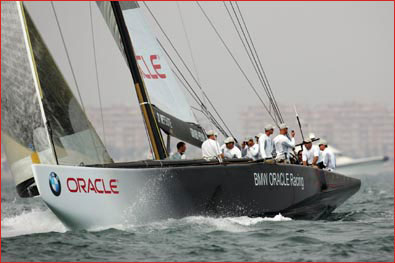 BMW Oracle has been carrying out some extensive TV trials of monohulls and multihulls in Valencia. The aim, says the Defender, is to work out which kind of boat is going to offer the biggest bang for buck in Russell Coutts’s vision of a more media-friendly and commercially-attractive America’s Cup...
BMW Oracle has been carrying out some extensive TV trials of monohulls and multihulls in Valencia. The aim, says the Defender, is to work out which kind of boat is going to offer the biggest bang for buck in Russell Coutts’s vision of a more media-friendly and commercially-attractive America’s Cup...
Read More
 BMW Oracle has been carrying out some extensive TV trials of monohulls and multihulls in Valencia. The aim, says the Defender, is to work out which kind of boat is going to offer the biggest bang for buck in Russell Coutts’s vision of a more media-friendly and commercially-attractive America’s Cup...
BMW Oracle has been carrying out some extensive TV trials of monohulls and multihulls in Valencia. The aim, says the Defender, is to work out which kind of boat is going to offer the biggest bang for buck in Russell Coutts’s vision of a more media-friendly and commercially-attractive America’s Cup...
America's Cup - April 2010
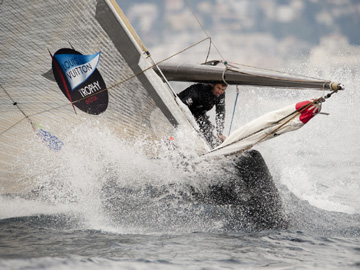 Louis Vuitton has been an integral part of the America’s Cup since the luxury goods company first gave its name to the Louis Vuitton Challenger Series back in Newport 1983. That close association continued up to Valencia 2007, but following Alinghi’s successful defence of the Cup, Louis Vuitton withdrew its backing...
Louis Vuitton has been an integral part of the America’s Cup since the luxury goods company first gave its name to the Louis Vuitton Challenger Series back in Newport 1983. That close association continued up to Valencia 2007, but following Alinghi’s successful defence of the Cup, Louis Vuitton withdrew its backing...
Read More
 Louis Vuitton has been an integral part of the America’s Cup since the luxury goods company first gave its name to the Louis Vuitton Challenger Series back in Newport 1983. That close association continued up to Valencia 2007, but following Alinghi’s successful defence of the Cup, Louis Vuitton withdrew its backing...
Louis Vuitton has been an integral part of the America’s Cup since the luxury goods company first gave its name to the Louis Vuitton Challenger Series back in Newport 1983. That close association continued up to Valencia 2007, but following Alinghi’s successful defence of the Cup, Louis Vuitton withdrew its backing...
33rd America's Cup, Part 5
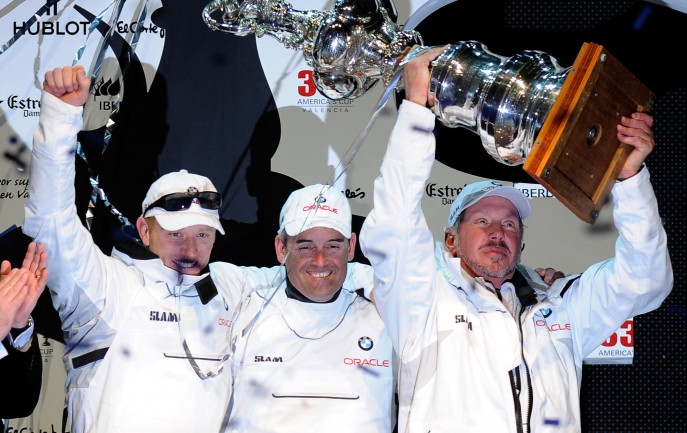 So now we’ve seen the power of wing rigs in action in the America’s Cup, what possibility of a trickledown of technology into other forms of sailing? What about superyachts? BMW Oracle’s design team director Mike Drummond observed, tongue in cheek: “If you go to Wings R Us.com, you can get any size you like.” Of course, this technology is anything but off the shelf, but nor is it new, as Drummond also pointed out: “Wings are not new, they’ve been used by birds for quite a long time...
So now we’ve seen the power of wing rigs in action in the America’s Cup, what possibility of a trickledown of technology into other forms of sailing? What about superyachts? BMW Oracle’s design team director Mike Drummond observed, tongue in cheek: “If you go to Wings R Us.com, you can get any size you like.” Of course, this technology is anything but off the shelf, but nor is it new, as Drummond also pointed out: “Wings are not new, they’ve been used by birds for quite a long time...
Read More
 So now we’ve seen the power of wing rigs in action in the America’s Cup, what possibility of a trickledown of technology into other forms of sailing? What about superyachts? BMW Oracle’s design team director Mike Drummond observed, tongue in cheek: “If you go to Wings R Us.com, you can get any size you like.” Of course, this technology is anything but off the shelf, but nor is it new, as Drummond also pointed out: “Wings are not new, they’ve been used by birds for quite a long time...
So now we’ve seen the power of wing rigs in action in the America’s Cup, what possibility of a trickledown of technology into other forms of sailing? What about superyachts? BMW Oracle’s design team director Mike Drummond observed, tongue in cheek: “If you go to Wings R Us.com, you can get any size you like.” Of course, this technology is anything but off the shelf, but nor is it new, as Drummond also pointed out: “Wings are not new, they’ve been used by birds for quite a long time...
33rd America's Cup, Part 4
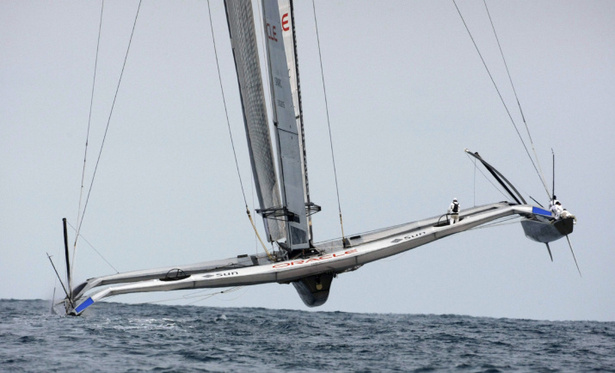 So now we know. Wings trump sails. Theory has always stated that a wing rig should be faster than conventional sails. But the challenge was actually to put a wing rig into practice, to be able to build it in less than six months, and also to manage the logistics of it...
So now we know. Wings trump sails. Theory has always stated that a wing rig should be faster than conventional sails. But the challenge was actually to put a wing rig into practice, to be able to build it in less than six months, and also to manage the logistics of it...
Read More
 So now we know. Wings trump sails. Theory has always stated that a wing rig should be faster than conventional sails. But the challenge was actually to put a wing rig into practice, to be able to build it in less than six months, and also to manage the logistics of it...
So now we know. Wings trump sails. Theory has always stated that a wing rig should be faster than conventional sails. But the challenge was actually to put a wing rig into practice, to be able to build it in less than six months, and also to manage the logistics of it...
33rd America's Cup, Part 3
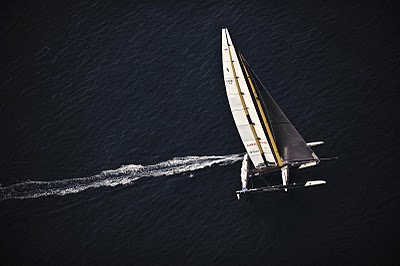 Race 2 was set to take place two days later on the Sunday. It was another long wait while Harold Bennett looked for suitable conditions in which to start the race. The cut-off time of 4pm was just minutes away when Bennett called for the start procedure to begin...
Race 2 was set to take place two days later on the Sunday. It was another long wait while Harold Bennett looked for suitable conditions in which to start the race. The cut-off time of 4pm was just minutes away when Bennett called for the start procedure to begin...
Read More
 Race 2 was set to take place two days later on the Sunday. It was another long wait while Harold Bennett looked for suitable conditions in which to start the race. The cut-off time of 4pm was just minutes away when Bennett called for the start procedure to begin...
Race 2 was set to take place two days later on the Sunday. It was another long wait while Harold Bennett looked for suitable conditions in which to start the race. The cut-off time of 4pm was just minutes away when Bennett called for the start procedure to begin...